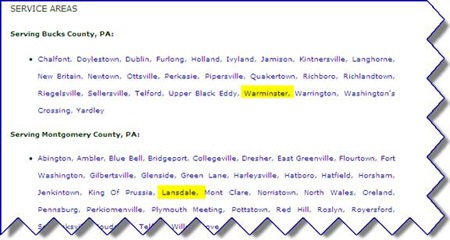One tactic frequently implemented successfully with Local SEO is the use of multiple URLs, or micro-sites. To help you better understand how this functions, I’ve chosen to use a real life example of a site network in current use that is neither affiliated with me nor with Search Engine Journal.
To begin, allow me to say that I will not be writing about how to implement this. You will be able to ascertain by reading between the lines how to do this (or by reading this post from the bottom up).
Rather, I will be explaining exactly how I was able to reverse engineer the SEO strategy of this particular business and the thinking that leads to my methodology.
My journey began with a search for the term ‘Warminster carpet cleaning’.
Directly below the Google Local results, appearing in position one, was the following:

I clicked through to this site and noticed something very odd….
The site had a handful of pages, but was specific to Warminster only?
Now, for anyone unfamiliar with Warminster (PA), it is a pretty small town. There’s no way a real carpet cleaning business would only service Warminster. There are dozens of towns within a few miles of Warminster yet the site does not mention any of them. That doesn’t make sense.
Between that oddity, and the fact that the URL exactly matched my original, non-branded search of ‘Warminster carpet cleaning’, I was able to conclude that there may be something worth looking into.
From here, I chose to begin searching for ‘carpet cleaning’ in other nearby towns to see if I could find something similar. After all, it’s only logical that if someone would use this tactic that they will own similar nearby geo URLs.
I chose to search in ‘Lansdale’.
Sure enough, when I searched for ‘Lansdale carpet cleaning’, I found virtually the exact same result:

The only difference was that the URL was an exact match for ‘Lansdale’ instead of ‘Warminster’.
The two sites are virtually identical (ie duplicate content) in every way if you look at the sites themselves.
So, now I wanted to know how many sites (geos) are within this network and how they are linked. I wanted to know how big this is, and how successful it is.
I could have simply done a domain lookup to see exactly what the registrant owns, but I also wanted to see their linking strategy for myself.
For this reason, I chose to use Yahoo Site Explorer to see how, if at all, there is inter-linking in play here. Plus, honestly, I was curious to see if the URL ranked because of the exact match or if the site may be buying links.
After choosing to have Site Explorer show links ‘Except from this domain’, this is the result:

It’s now clear that the only site linking to ‘Warminstercarpetcleaning.com’ is ‘AllClean1.com’. The same holds true for ‘Lansdalecarpetcleaning.com’.
This means, when I go to ‘AllClean1.com’, I’ll probably find the core of this network and some of the answers I was looking for.
Sure enough, right in the footer of ‘AllClean1.com’, is the list of every geo included in the network, with links to outside ‘<Geo>CarpetCleaning’ URLs.

I have now been able look at a single ranking, and use a bit of competitive intelligence to rip apart the local SEO strategy this company is effectively implementing.
This is not only an effective tactic for competitive intelligence, but for education as well. It’s a great way to learn SEO or SEM. It’s also a great test project to give an employee to see if they can determine the correct answer.
This particular case study left me with a bunch of questions I’m hoping the readers have answers to. Do you think that the mainly duplicate sites pose a long term problem to the current effectiveness here? Is there an opportunity to create your own business model from what you’ve just seen? Do you look at rankings and do this in your free time, too? Please comment below and let everyone know what you think.
Matt Leonard currently directs SEO, SEM and Revenue Management for Cruise Critic, the world’s largest cruise site and part of the Trip Advisor Media Group. You can follow Matt Leonard on Twitter to keep up with his updates.




![AI Overviews: We Reverse-Engineered Them So You Don't Have To [+ What You Need To Do Next]](https://www.searchenginejournal.com/wp-content/uploads/2025/04/sidebar1x-455.png)